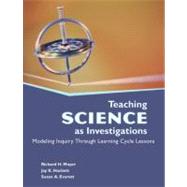
Note: Supplemental materials are not guaranteed with Rental or Used book purchases.
Purchase Benefits
Looking to rent a book? Rent Teaching Science as Investigations Modeling Inquiry Through Learning Cycle Lessons [ISBN: 9780132186278] for the semester, quarter, and short term or search our site for other textbooks by Moyer, Richard H.; Hackett, Jay K., Professor Emeritus; Everett, Susan A.. Renting a textbook can save you up to 90% from the cost of buying.
| An Introduction to Science Learning | |||||
|
1 | (16) | |||
|
17 | (100) | |||
|
18 | (25) | |||
|
19 | (8) | |||
|
27 | (9) | |||
|
36 | (7) | |||
|
43 | (23) | |||
|
44 | (8) | |||
|
52 | (7) | |||
|
59 | (7) | |||
|
66 | (25) | |||
|
67 | (7) | |||
|
74 | (7) | |||
|
81 | (10) | |||
|
91 | (26) | |||
|
92 | (10) | |||
|
102 | (9) | |||
|
111 | (6) | |||
|
117 | (104) | |||
|
118 | (24) | |||
|
119 | (8) | |||
|
127 | (9) | |||
|
136 | (6) | |||
|
142 | (24) | |||
|
143 | (10) | |||
|
153 | (9) | |||
|
162 | (4) | |||
|
166 | (24) | |||
|
167 | (8) | |||
|
175 | (7) | |||
|
182 | (8) | |||
|
190 | (31) | |||
|
191 | (9) | |||
|
200 | (13) | |||
|
213 | (8) | |||
|
221 | (94) | |||
|
222 | (21) | |||
|
223 | (7) | |||
|
230 | (6) | |||
|
236 | (7) | |||
|
243 | (25) | |||
|
244 | (10) | |||
|
254 | (7) | |||
|
261 | (7) | |||
|
268 | (25) | |||
|
269 | (10) | |||
|
279 | (6) | |||
|
285 | (8) | |||
|
293 | (22) | |||
|
294 | (8) | |||
|
302 | (5) | |||
|
307 | (8) | |||
| In Conclusion Developing Learning Cycle Lessons | 315 | (6) | |||
| Appendix I K--4 National Science Education Standards | 321 | (4) | |||
| Appendix II 5--8 National Science Education Standards | 325 | (6) | |||
| Appendix III NSTA Position Statement: Safety and School Science Instruction | 331 | (2) | |||
| Index | 333 |
The New copy of this book will include any supplemental materials advertised. Please check the title of the book to determine if it should include any access cards, study guides, lab manuals, CDs, etc.
The Used, Rental and eBook copies of this book are not guaranteed to include any supplemental materials. Typically, only the book itself is included. This is true even if the title states it includes any access cards, study guides, lab manuals, CDs, etc.